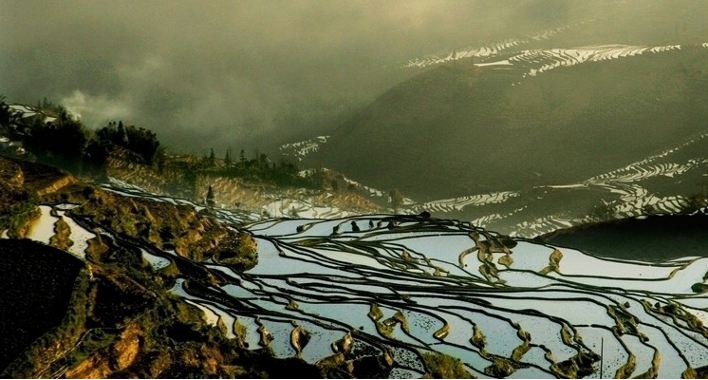
This article is a travel guide to Yunnan Province, in the South West of China. It was written by Harley Greenberg, who works with a local travel agency (WindhorseTour) in China.
Travel to Yunnan – Index
Yunnan Province is famous for its diverse scenery and for being home of a third of all China’s ethnic minorities. It has lots to offer any traveler!
Yunnan basic travel facts
A trip to Yunnan province realistically takes at least one week. However, if you want to cover all the highlights I encourage you to spend twelve days or longer.
A trip to Yunnan is a breathtaking view of some of the most spectacular and overwhelming scenery within China. You can watch the sun rise and set on the magnificent Yuan Yang rice terraces; escape the crowds and enjoy the days exploring the less visited Lugu Lake, or get lost among the canals and cobbled lanes of Lijiang ancient town or Dali Cang Mountain.
Yunnan’s climate is diverse as its terrain, for many places such as Dali there is an ideal temperature – an eternal spring – that attracts tourists all year-round. The northwestern region around Shangri-la is situated on the Tibetan plateau and can be very cold during winter.
I find the best time and also peak season for traveling Yunnan is from April to October, when the vegetation is a lush green and flowers are in bloom.
Yunnan can be easily accessed by air, bus and trains from most cities across China. Kunming, the capital, is served by all Chinese airlines and has daily flights to most cities.
Other popular attractions such as Lijiang, Dali and Shangri-la also have airports with connecting flights offered from Kunming and other major cities in China. Another option is to take the train – or the bus – that goes from Kunming to Lijiang (via Dali).
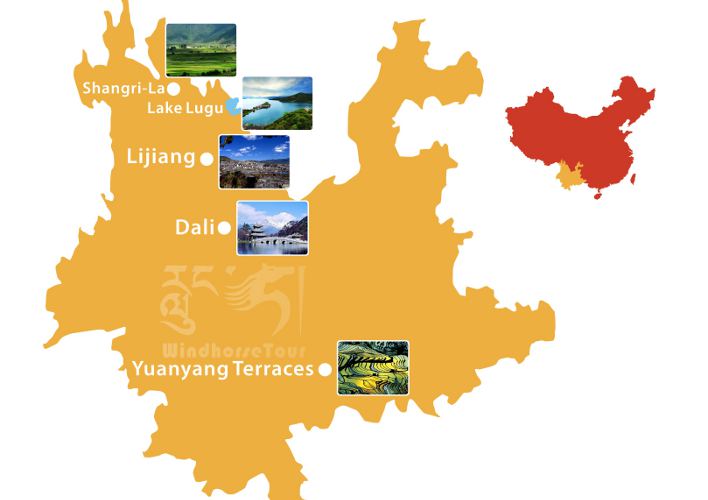 A touristic map of Yunnan Province.
A touristic map of Yunnan Province.
Itineraries
Here some possible itinerary to visit Yunnan Province:
- Kunming – Stone Forest – Dali – Lijiang – Shangri-La and then back to Kunming or up to Sichuan.
- Kunming – Stone Forest – Dali – Lijiang -Lugu Lake and then back to Lijiang or up to Sichuan.
- Kunming – Yuan Yang and then back to Kunming, East to Guanxi Chinese Province or South to Vietnam.
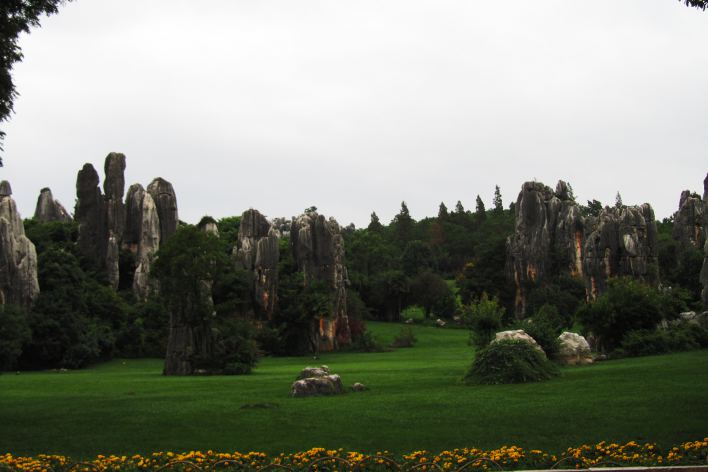 Shilin, The Stone Forest near Kunming.
Shilin, The Stone Forest near Kunming.
The Stone Forest
The Stone Forest (or Shilin, in Mandarin) is a beautiful park composed by limestone formations.
You can get there by private car, taxi or taking the bus that leaves from Kunming every hour (the trip takes about ninety minutes). The Stone Forest is quite popular, especially among Chinese tourists. This means that most days by nine am it will be jam packed, this is one reason why clients that visit the forest tend to don’t recommend it. However when asked if they are glad they went the answer is “yes”. So there you have it.
A hint on how best to enjoy the Stone Forest is to travel there with an agency that brings you early on or head to Lunan – the near by town – the night before so you can wake up early and visit it before the buses from Kunming start to arrive (normally around nine am). For more info you can read this story published here on the site longtime ago.
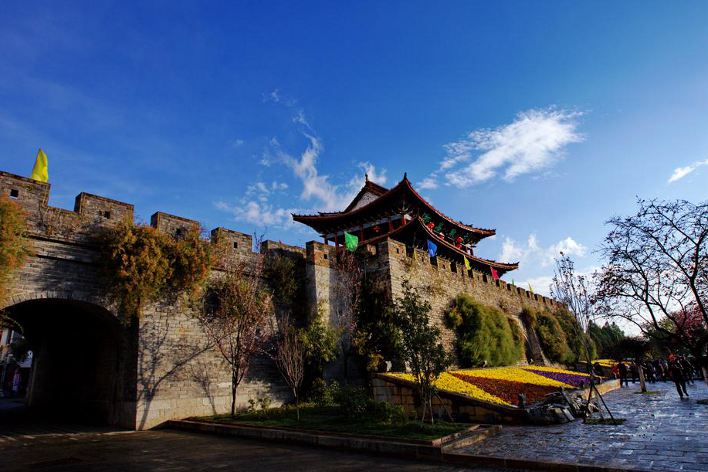 The North Gate at Dali Ancient Town.
The North Gate at Dali Ancient Town.
Dali Ancient City
Dali is one of those few places in China with an infectious ambiance, an environment that seem to attract many Chinese backpackers. Don’t be surprised when you find some of them sitting around strumming their guitars and telling tales of their travels.
With over 2,000 years of history, Dali shares a glorious past of being the former capital of the Nanzhao Kingdom, a powerful entity separate from China. It lies on the western edge of Erhai Lake at an altitude of 1,900 m (6,234 ft.), with a backdrop of the imposing 4,000 m (13,123 ft.) tall Jade Green Mountain (Cang Shan in Chinese). You can climb it using the stairs but be careful to do not lose yourself.
Flights are probably the most popular transportation to get to Dali. You can also choose an overnight sleeper train from Kunming or take a bus, always from Kunming, that will take around four hours.
Within the heart of Dali still lives the ancient city that retains a historical atmosphere that is hard to come by in other parts of China.
A short distance northwest from the old town stand the Three Pagodas (you can walk till there). Like 3 guardians this landmark is a definite “can’t miss” attraction in the city. The tallest of the three has 16 tiers, reaching 72 m. (234 ft.), and was originally constructed in the 9th century.
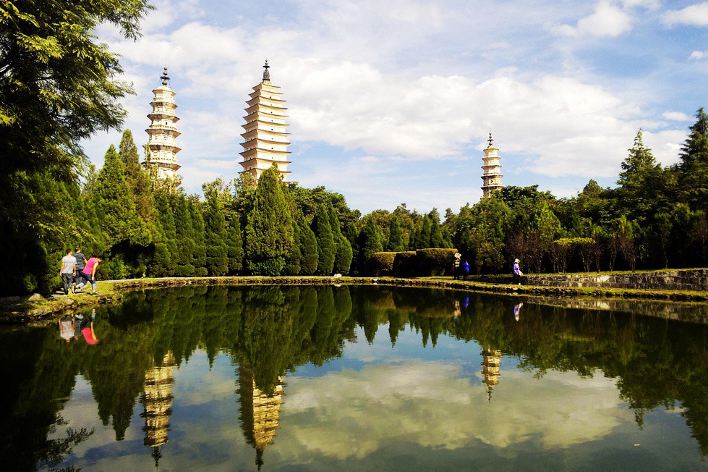 The Three Pagodas, Dali.
The Three Pagodas, Dali.
The countryside around Dali can also be dazzling, with small fascinating temples, and the occasional village showcasing exquisite traditional local architecture.
A good start is to visit the Zhonghe Temple. You can climb the paths that snake their way up and see the marvelous views of Erhai Lake.
Other way to explore Erhai Lake is by either renting a bike or zipping across the water on the many ferries that crisscross the lake. Roads now encircled the lake so it is possible to do a loop of the lake by mountain bike. There are some small villages dotted along the way for you to buy food and water.
24 km. (15 mi.) north of Dali, the old town of Xizhou is a must-see to extend your cultural trip in Dali. Much of the original Bai architecture is well preserved. Here you will witness the local courtyards with children play, chickens squawk, dogs fight, and all the rhythms of family life play out.
When the night falls, find a bar at the Foreigner’s Street, sit back with foaming cappuccinos and banana pancakes, there is another singer telling his stories in Dali.
Click here to read SDC’s hotel recommendation in Dali.
 Lijiang Ancient Town.
Lijiang Ancient Town.
Lijiang Ancient Town
In the foothills of Qinghai-Tibet Plateau lies Lijiang, a splendid little town that is home to the Naxi people. Filled with a maze of cobbled stone streets, rickety old wooden buildings and gushing canals makes it one of the most visited sites in northern Yunnan. Here you will find the stunning Jade Dragon Snow Mountain that presents a splendid backdrop viewable from across Lijiang.
Beyond Jade Dragon Snow Mountain lies one of the most popular backpackers destination in Yunnan, Tiger Leaping Gorge. Most travelers will spend two days hiking within Tiger Leaping Gorge.
Lijiang can be easily accessible by air, bus and trains from Kunming and other big cities in China.
A visit here requires at least two days to take a glimpse of the highlights this town has to offer. However, I would suggest you arrange a local guide either local or along with a private tour. This will help your to better understand the rich culture of the region and history of the nearby Baisha and Shuhe Villages.
Here the most popular attractions in Lijiang:
- Dayan ancient Town: It is one of the main draws for people coming to Lijiang. The whole town is crisscrossed by canals, bridges and a maze of narrow streets. Dayan is full of traditional Naxi architectures that still today fills the town. As you walk through the narrow street you will observe the many wooden doors that are left open to reveal the interiors of both Naxi and Western restaurants.
- Black Dragon Pool: As you head towards the north you will reach the Black Dragon Pool. One of the most popular vantage points of Jade Dragon Snow Mountain.
- Dongba Culture Museum: If you fancy museums stop and visit the Dongba Culture Museum dedicated to the Shamanistic Dongba religion.
Jade Dragon Snow Mountain: A visit to the Jade Dragon Snow Mountain is a must-do in Lijiang. 34 km. (21 mi.) north of Lijiang, this mighty mountain rises raggedly above the ancient town. The mountain’s summit soars to 5,596 m. (18,354 ft.), encrusted with snow and set against a sharp, blue sky.
Located at 4,506 m (14,784 ft.), Cloud Fir Meadow is the highest point you can ascend to at Jade Dragon Snow Mountain. The walkways provided to help protect the environment lead you to some awesome glacier views.
Be warned that the elevation here can make some people feel uncomfortable. Mind your health and tell your guide immediately if you start feeling queasy.
Tiger Leaping Gorge: For further exploration in Lijiang, head over to Tiger Leaping Gorge. A hike here is a “can’t miss” experience of Northern Yunnan.
The gorge is considered one of the deepest in the world. With Jade Dragon Snow Mountain in the back, the Jinsha River flowing through the gorge and later swelling into the Yangtze River it offers a dramatic and thrilling journey to travelers.
The nightlife in the ancient town is lively! Chinese people believe this is one town filled with romance. Also, there are many bars and western cafes in the old town. With a cold beer in your hand and exotic music in the air, it offers you a great place to experience the Lijiang nightlife and perhaps find your true love.
Click here to read SDC’s hotel recommendation in Lijiang.
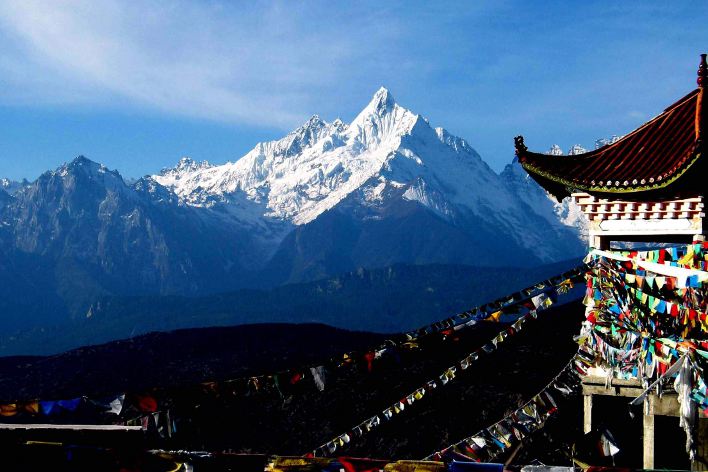 Mount Meli, Shangri-la.
Mount Meli, Shangri-la.
Shangri-la
Traveling along the northern route of Yunnan, Shangri-la is the last stop for most travelers. It is home to several remote temples, rugged scenery and is the start of the Tibetan world.
Originally called Zhongdian, this place has attracted travelers since it was declared the location described on the novel The Lost Horizon written by the British writer James Hilton.
While we cannot confirm or deny James Hilton intention, the real Shangri-la exists today. The real scenery you will witness here is awe-inspiring, and the people are some of the warmest heartiest in the world.
If you cannot make a Tibet tour, Shangri-la is a pretty popular runner up to get a taste of Tibetan cultures. However, I would still suggest a trip into western Sichuan if you are craving Tibetan culture and cannot travel into the Tibet Autonomous Regional.
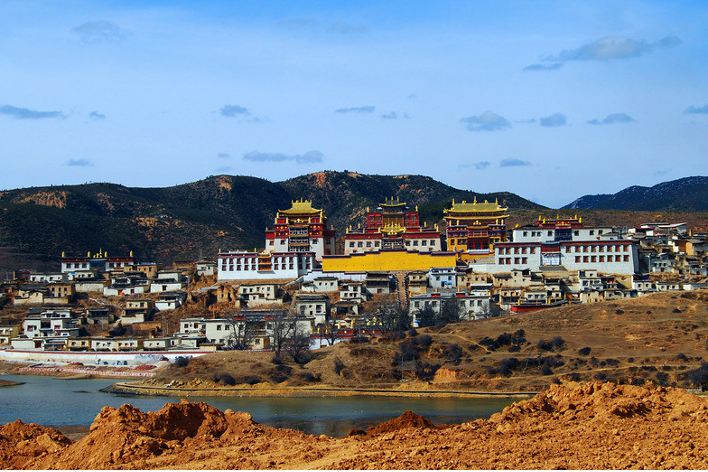 The “Little Potala Palace,” a Tibetan monastery in Shangri-la, Yunnan, Tibetan Plateau.
The “Little Potala Palace,” a Tibetan monastery in Shangri-la, Yunnan, Tibetan Plateau.
Within Shangri-la there are Tibetan towns, named Gyeltang or Gyalthang, where you can experience the daily life of Tibetan people.
About an hour’s walk north of the town is the Ganden Sumtseling Gompa. One of the main reasons people to come here is to see the little Potala Palace. This monastery was built based on the layout of the Potala Palace in Lhasa, and is home to countless Tibetan Buddhist treasures.
The view of town from the top of Ganden Sumtseling is gorgeous. A sunset from here is particularly picturesque among the tinkling bells and fluttering prayer flags.
Shangri-la is a wonderful place to get off the beaten track.
I encourage you to spend some time trekking or horse riding to explore the surrounding areas. There are many less visited monasteries and villages.
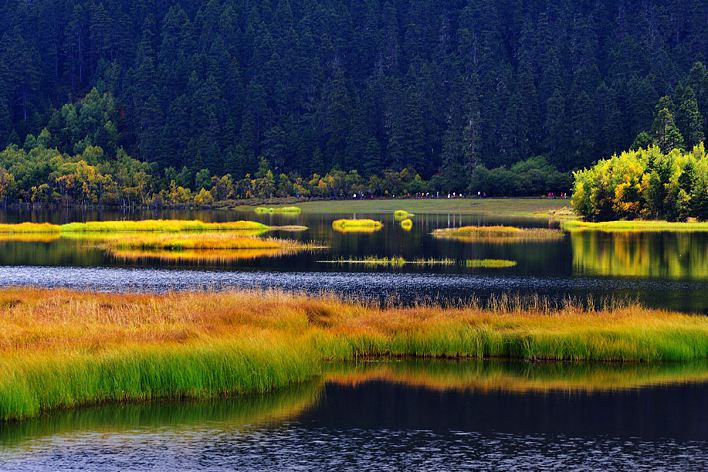 Shangri-la’s Pudacuo National Park.
Shangri-la’s Pudacuo National Park.
There is a severe lack of reliable public transportation in these remote areas, so be prepared to hire a local driver for a couple of days or consider organizing a private tour with a local guide who will share with you the intricate details of her culture.
When visiting in Shangri-la, I suggest you spend a day at Pudacuo National Park, which is composed by two beautiful lakes, Bita Hai and Shudu Lake.
Fed by small streams from the snow mountains encircled, Bita Hai Lake resembles a trumpet shell. The picturesque scenery of the pure green water with snow mountains and trees reflecting in it will offer you a great photography chance. The Shudu lake is home to lush plants and various wild animals.
Shangri-la is also popular for being the “backdoor” access to Yunnan Province from Sichuan (the main and easier route being the train Chengdu-Kunming). Be aware that for enter (or exit) Yunnan from Shangri-la you’ll have to travel by bus through the Tibetan Plateau, which isn’t always opened to foreigners and it may take up to two days.
SDC’s cheap hostel recommendation in Shangri-la: Shangri-La Lamtin Youth Hostel.
SDC’s hotel recommendation in Gyalthang (it’s not that cheap but it’s were I slept and it’s awesome, check the pics of the bedrooms!): Shangri-la Gyalthang Dzong Hotel.
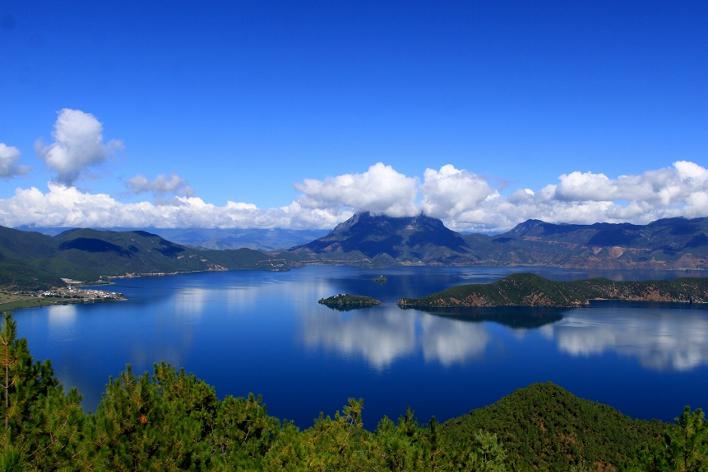 Lugu Lake.
Lugu Lake.
Lugu Lake
This forest lined lake overlaps the remote border between Yunnan – Sichuan provinces. It is home to several Tibetan, Yi as well as Mosuo minority villages.
The stunning scenery and ethnic cultures are two main features that attracts thousands of visitors.
A visit to the Lugu usually can be started from Luoshui. The lake, was formed by two sinking faults, and this high alpine lake sits 2,685 m. (8,809 ft.). Most people say it is shaped like a horse’s hoof – long from north to south, and narrower from East to West.
The lake which is surrounded by hills is filled with inviting clear water, that makes it easy to see the fish swimming within. The forest that protects the lake if full of dense trees and fresh mountain.
Lugu Lake is a place that has not been disturbed by the other economic developments and pollution; its’ natural beauty has been retained.
The weather is pleasant – it is cool in summer and warm in winter.
From Luoshui you can visit several islands on the lake by dugout canoe: Liwubi Island is the largest island where you can practically wade across to a spit of land in Sichuan; Heiwawu Island is in the center and has a variety of birds living on it; the smallest is Nixi Island, an oblong rock covered with shrubs and moss.
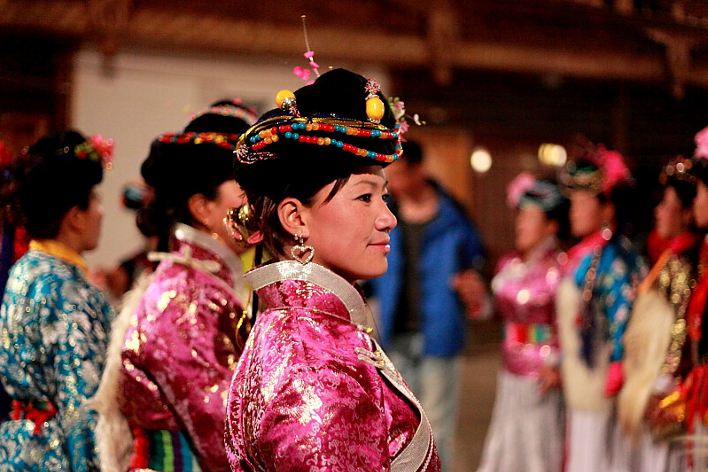 Mosuo women.
Mosuo women.
One of the main reason Lugu Lake has maintained its’ mystery and charm is because the Mosuo people who live here. The Mosuo are the last practicing (almost) matriarchal society in the world.
Mosuo women never marry and never cohabit, instead they are free to choose as many lovers as they like throughout their lives.
Children are brought up by women, and use the surname of their mothers. Families are composed of the members of the matrilineal kind. Women hold the principal positions in the society, forming a modern day ‘woman’s kingdom’, which adds mystique to this magical place.
The best time to visit Lugu Lake are April to May, and September to October, when the weather is dry and mild.
In order to reach Lugu Lake you’ll have to take a bus or private minibus from Lijiang (it should take around seven hours to arrive here).
p.s. You can enter Sichuan also through Lugu Lake. You’ll have to take a bus till Xichang (the trip takes about seven hours) and then a train till Chengdu (you may want to stop at Emei Shan, one o the holy Buddhist mountains and Leshan, where you can admire the biggest statue of Buddha in the world).
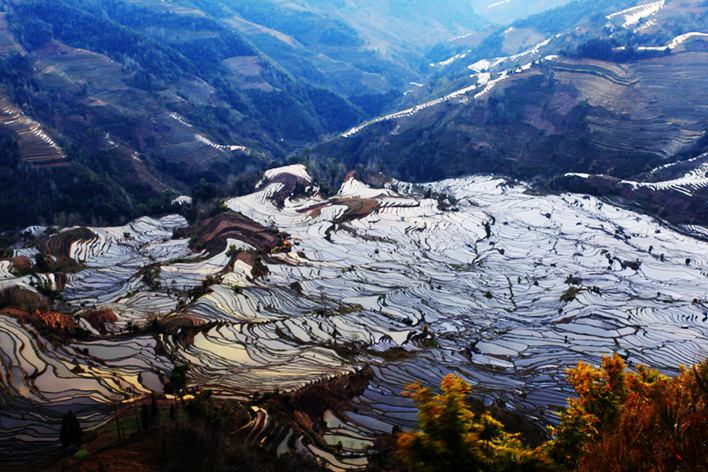
Yuan Yang Rice Terraces
Yunnan is a destination that is never lacking of natural beauty. However the last place I want to recommend to you is famous for its spectacular man made sights.
The famed rice terraces are slopes claimed from nature for cultivation in these hilly and mountainous areas. Some are hundreds or even thousands of years old.
Yuan Yang, located in the south of Yunnan, is one of the two most popular places to capture this unique sight in China. Fashioned over hundreds of years by the ancient Hani people, Yuan Yang Rice terraces cover roughly 125 sq. km. (48 sq. mi.).
A proper trip to the rice terraces can be done in two days when driving from Kunming. For those willing to spend more time a three days visit offers a chance to explore deeper into the local culture.
The scenery here is amazing and each year Yuan Yang attracts numerous photographers who flock here to capture the spectacular sunrise and sunsets that convert the terraces into pools of gold, red and silver.
Even in poor weather the views can still be breathtaking! When the fog rolls into the terraced valleys leaving only the hilltop village visible, the effect is dramatic. Many describe it as islands floating in the clouds.
Xinjie is the traditional starting point near Yuan Yang to reach the rice terraces. It is the recommended place to start any trip.
The terraces around each of the dozens of villages that you will find here have their own special characteristics which vary from season to season. Having a local guide helps to determine which terrace matches with your interest and helps to find the best ones given the time of year you visit.
To help you plan your trip, here are several popular photography places within Yuan Yang Rice Terraces:
- Duoyishu, about 25 km. (16 mi.) from Xinjie, has the most spectacular sunrises and is one you should not miss.
- Bada and Laohuzui are two of the best places to capture the sunsets. The scenery can be mesmerizing.
- Longshupa Scenic Spot is famous for its closest views of the terraces, while Mengpin is splendid for the bird’s eye view of the terraces.
Besides these landscapes, the unique mushroom-shape Hani houses and Hani costumes are also great for photography.
The rice harvest will traditionally occurs in early September and the fields will remain dry till December when flooded again. The fields are then again filled with water in December.
I advise you to plan your trips from January to March, when the seas of clouds above the terraces are most likely to be witnessed. In early spring according to the Chinese lunar calendar (from late February to March), the terraces are filled with wild flowers, including pink peach blossom and white pear blossom.
Yuan Yang lies on the Tropic of Cancer, so the climate is neither extremely hot nor cold.
However, it is cooler in morning and evening, and the sun is very strong at noon. So pay attention to the sun and wear proper protection. Moreover, T-shirts and shorts can be worn all year round, but you are advised to take a jacket.
In addition to capturing the picturesque scenery, exploring the unique Hani ethnic cultures at the surrounding villages is also an interesting experience not to miss. Participate in a local country fair, during which the entire minority people dress in colorful ethnic costumes, you will find it is very lively.
p.s. Here you find all you need to know to book your hotel (or hostel) in China.
Frequently asked questions
Also, bring some sunblock and sunglasses as the sun is strong. You should also try to buy a hat or a cap beforehand or when arriving. Preferably, you should also buy medicine which prevents high-altitude disease and also oxygen, if you’re to ascend the mountains.
Photo Credits: Photos by Harley Greenberg



Thanks so much for sharing. 🙂 zinbeauty
This website is great, thank you!
I’m planning to visit Yunnan this summer. I’ve read info on the Chinese Embassy in my country about Covid-19 policies, and it says that one should refer to the dispositions given by the local authorities. I’ve tried to find out whether in Yunnan some rules still apply, but I couldn’t find anything – I can’t speak Mandarin *that* well.
Do you know something about this issue? Where should I seek info?
As far as I know at the moment, there aren’t any restrictions and it’s unlikely that the situation will change this summer. However, here in China the situation can change really fast.
I have never been in Yunnan before, but spent quite some time in south east Asia. It is different word, but those are the places in my opinion worth visiting. Culture, people, way of living and the way of thinking if you want. It is great you not only visited Yunnan, but also described you journey in details here. Thank you!
Yunnan is an incredible place and culturally close to Southeast Asia
Yunnan is an extremely beautiful destination to visit also Yunnan is full of natural beauty. Next month, gonna plan to visit here. This travel guide is full of useful travel information. Thanks for sharing this informative post. Keep sharing the good work ahead……Bookmarked for the future read. If you are planning to visit Morocco, Visit us here. We are best hotels in Marrakech, Morocco
Visiting Yunnan is probably the part of my Asia trip Im the most excited about! It just seems as if there are so many beautiful places :) Im planning to visit Feilai si in Deqin, you have any tips for doing so? The mountains there seem absolutely incredible!
Hello Niclas,
the only tip I can give you for a specific spot is the following: sometimes in Yunnan is difficult to find public transportation for short trips. In this case the best way is to rent a car with a driver for a day (usually is not expensive). You can ask to your hotel reception to help you finding a driver, it shall not be too difficult
Hi. My husband and I are thinking of going to Yunnan from September 30th until October 4th. We are thinking of just going to one place so we are not rushing on one place to another. Which one would you recommend? Our choices are Dali, Shangri La and Lijiang.
Probably Dali is the best choice. Lijiang is too crowded and Shangri-La had a big fire on 2014 so I don’t know if it’s still a beautiful place to visit
Are night buses between Kunming and Yuanyang safe for two female travelers!?
Hello Jaimie,
yes, there are night buses
Your article has been a great help in me deciding to travel Yunnan for ten days with my boyfriend. I am living in Shanghai for three months and this is the only big trip that we will take. If I am coming from Shanghai and only have ten days.. do you recommend a specific set of places to visit? You have provided three options in this article, I wonder if you could say which you think would be most suitable? I want to spend as little time as possible travelling and being on buses (I get very travel sick). I’m aware that a lot of travelling will need to be done between places but want to keep it to as much of a minimum as possible. Maybe you could recommend routes that have night trains for example? We are most interested in seeing beautiful nature and wonderful scenery. We are both very fit so lots of climbing, hiking, cycling etc would be wonderful. Thanks so much, looking forward to hearing your advice!
Hello Lucy,
if you have troubles traveling, the easiest itinerary is Kunming-Dali-Lijiang-Shangri La.
I think the longest trip by bus is Kunming-Dali, which is just 4 hours.
You will find a ton of nature near all these 3 cities!
Dear Furio,
I am planning a trip in spring next year.
Arrive in Kunming (one day), onwards to Dali (one night), then Lijiang (one night), Tiger Leaping Gorge, then back to Lijiang. Onwards to Zhongdian. Have not decided whether to go onwards to Chengdu or back to Kunming to catch an international flight out of China.
I know I won’t be able to see all recommended places so my priorities will be Lijiang, TLG and Zhongdian.
Due to a tight schedule and budget, what’s the fastest way, other than flights? Train or bus? Will I be able to save if I take overnight buses or trains?
Thanks!
Hello Audry, you really have a tight scheduling here…
If your priority is Lijiang, I’d catch a night train Kunming – Lijiang to save time (although personally I prefer Dali to Lijiang).
Zhongdian is only 2-3 hours by bus from Lijiang, and the Tiger Leaping Gorge is on the way, thus in this case a night train / bus is not needed.
Yes, China is pretty safe.
Dear All, I would like to visit Yunnan for 5 days arriving on 31 December 2017. I would like to include in the itinerary : (1) Shillin Stone Forest (2) Black Dragon Pool Park (3) Jade Dragon Snow Mountain (4) Tiger Leaping Gorge and
(5) Zhongdian/Shangri-la. Please add other destinations which you think should be included.
It will be for 2 adults. We would like to stay at the Intercontinental in Kunming, then Grand Hyatt in Lijiang and the Songtsam in Zhongdian/Shangri-la.
Is December and January a bad time to visit the places in my itinerary for Yunnan?
Will cold, icy weather and snow interfere with travel?
What percentage of shops and restaurants will be closed at this time of year?
I look forward to your reply.
Hello Maria,
the itinerary seems ok, maybe even too much for only 5 days!
In winter Shangri-la may be cold as it’s on the Tibetan plateau
Awesome info – thank you for sharing! Is there a faster way to get to the Yuanyang area? Wondering if there’s a closer airport if we’re flying in from Beijing so we don’t have to spend as much time on a bus. Yunnan looks spectacular!
Shannon, there’re several regular flights from Beijing to different Yunnan’s cities as Kumming (the capital), Dali, Shangri-la and Lijiang. Beijing-Kumming is normally the cheapest. You can check it out in the ctrip website.
Hi there,
China is the safest country I’ve visited so far. And I’ve visited quite a few countries : P
Harley Greenberg is a teacher? Please tell me he isn’ t teaching English. The article is littered with mistakes.
Wow thank you for the constructive comment Ruby; keep them coming : )))